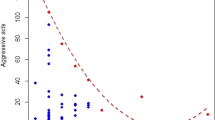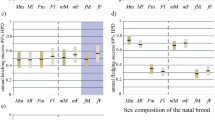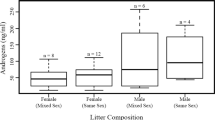Abstract
Among spotted hyenas, Crocuta crocuta, neonatal aggression in twins is a well-known phenomenon and serves to establish intra-litter dominance soon after birth. As the stronger more aggressive cub presumably attains dominance over its twin, intra-litter dominance presents mothers with an ideal opportunity to assess individual cub fitness and, thereafter, to selectively favor one cub over the other. This study quantified maternal response to sibling conflict in 26 sets of twins born to 16 wild-living females to determine whether mothers of different social ranks exhibited favoritism towards sons or daughters, or in the case of same-sex twins, the dominant or subordinate cub. Maternal response to sibling conflict did not vary with litter sex composition, suggesting that mothers do not favor offspring of one sex over the other. All mothers intervened when their cubs fought and sometimes punished their cubs. Higher-ranking mothers more often punished both cubs, while lower-ranking mothers were more selective and punished the dominant cub. Where sibling aggression was most extreme, rather than favor the dominant sibling, mothers of all ranks made concessions to the subordinate cub that included procuring private nursing bouts for the subordinate and temporarily housing twins in separate dens, presumably to decrease sibling conflict. These findings represent a complex example of parent–offspring conflict and support both the insurance cub hypothesis and resource tracking hypothesis that mothers endeavor to keep all offspring alive for as long as possible in the event that the dominant sibling dies or that resources provide for the rearing of twins.



Similar content being viewed by others
References
Clutton-Brock TH, Albon SD (1982) Parental investment in male and female offspring in mammals. In: Group KCS (ed) Current problems in sociobiology. Cambridge University Press, Cambridge, pp 223–247
Drea CM, Hawk JE, Glickman SE (1996) Aggression decreases as play emerges in infant spotted hyaenas: preparation for joining the clan. Anim Behav 51:1323–1336
East ML, Hofer H (2001) Male spotted hyenas (Crocuta crocuta) queue for status in social groups dominated by females. Behav Ecol 12:558–568
East ML, Burke T, Wilhelm K, Greig C, Hofer H (2003) Sexual conflicts in spotted hyenas: male and female mating tactics and their reproductive outcome with respect to age, social status and tenure. Proc R Soc Lond B 270:1247–1254
Engh AL, Funk SM, Van Horn RC, Scribner KT, Bruford MW, Libants S, Szykman M, Smale L, Holekamp KE (2002) Reproductive skew among males in a female-dominated mammalian society. Behav Ecol 13:193–200
Forger NG, Frank LG, Breedlove SM, Glickman SE (1996) Sexual dimorphism of perineal muscles and motoneurons in spotted hyenas. J Comp Neurol 375:333–343
Frank LG (1986a) Social organization of the spotted hyena (Crocuta crocuta): I. Demography. Anim Behav 34:1500–1509
Frank LG (1986b) Social organization of the spotted hyena Crocuta crocuta: II. Dominance and reproduction. Anim Behav 34:1510–1527
Frank LG (1994) When hyenas kill their own. New Scientist, pp 38–41
Frank LG (1996) Female masculinization in the spotted hyena: endocrinology, behavioral ecology, and evolution. In: Gittleman JL (ed) Carnivore behavior, ecology, and evolution, vol II. Cornell University Press, Ithaca, pp 78–131
Frank LG, Glickman SE, Powch I (1990) Sexual dimorphism in the spotted hyena Crocuta-crocuta. J Zool (London) 221:308–313
Frank LG, Glickman SE, Licht P (1991) Fatal sibling aggression, precocial development, and androgens in neonatal spotted hyenas. Science (Washington, DC) 252:702–704
Frank LG, Holekamp KE, Smale L (1995) Dominance, demography, and reproductive success of female spotted hyenas. In: Sinclair ARE, Arcese P (eds) Serengeti II: dynamics, management, and conservation of an ecosystem. University of Chicago Press, Chicago, pp 364–384
Glickman SE, Frank LG, Pavgi S, Licht P (1992) Hormonal correlates of “masculinization” in female spotted hyaenas (Crocuta crocuta): 1. Infancy to sexual maturity. J Reprod Fertil 95:451–462
Glickman SE, Coscia EM, Frank LG, Licht P, Weldele ML, Drea CM (1998) Androgens and masculinization of genitalia in the spotted hyena (Crocuta crocuta). 3. Effects of juvenile gonadectomy. J Reprod Fertil 113:129–135
Golla W, Hofer H, East ML (1999) Within-litter sibling aggression in spotted hyaenas: effect of maternal nursing, sex and age. Anim Behav 58:715–726
Gowaty PA, Lennartz MR (1985) Sex ratios of nestling and fledgling red-cockaded woodpeckers, Picoides borealis, favor males. Am Nat 126:347–353
Hamilton WD (1964) The genetical evolution of social behavior. J Theor Biol 7:1–16
Hamilton WD (1967) Extraordinary sex ratios. Science 156:477–488
Henschel JR, Skinner JD (1987) Social relationships and dispersal patterns in a clan of spotted hyenas Crocuta crocuta in the Kruger National Park [South Africa]. S Afr J Zool 22:18–24
Hofer H, East ML (1993) The commuting system of Serengeti spotted hyaenas: how a predator copes with migratory prey: III. Attendance and maternal care. Anim Behav 46:575–589
Hofer H, East ML (1997) Skewed offspring sex ratios and sex composition of twin litters in Serengeti spotted hyaenas (Crocuta crocuta) are a consequence of siblicide. Appl Anim Behav Sci 51:307–316
Hofer H, East ML (2003) Behavioral processes and costs of co-existence in female spotted hyenas: a life history perspective. Evol Ecol 17:315–331
Hofer H, East ML (2007) Siblicide in Serengeti spotted hyenas: a long-term study of maternal input and cub survival. Behav Ecol Sociobiol DOI 10.1007/s00265-007-0421-3
Holekamp KE, Smale L (1991) Dominance acquisition during mammalian social development the inheritance of maternal rank. Am Zool 31:306–317
Holekamp KE, Smale L (1995) Rapid change in offspring sex ratios after clan fission in the spotted hyena. Am Nat 145:261–278
Holekamp KE, Ogutu JO, Dublin HT, Frank LG, Smale L (1993) Fission of a spotted hyena clan: consequences of prolonged female absenteeism and cause of female emigration. Ethology 93:285–299
Holekamp KE, Smale L, Szykman M (1996) Rank and reproduction in the female spotted hyaena. J Reprod Fertil 108:229–237
Holekamp KE, Cooper SM, Katona CI, Berry NA, Frank LG, Smale L (1997a) Patterns of association among female spotted hyenas (Crocuta crocuta). J Mammal 78:55–64
Holekamp KE, Smale L, Berg R, Cooper SM (1997b) Hunting rates and hunting success in the spotted hyena (Crocuta crocuta). J Zool (London) 242:1–15
Hrdy SB (1985) Parental investment in sons vs. daughters. Am J Phys Anthropol 66:182
Hudson R, Trillmich F (2007) Sibling competition and cooperation in mammals: challenges, developments and prospects. Behav Ecol Sociobiol DOI 10.1007/s00265-007-0417-z
Kruuk H (1972) The spotted hyena: a study of predation and social behavior. University of Chicago Press, Chicago
Mills MGL (1990) Kalahari hyaenas: comparative behavioural ecology of two species. Unwin Hyman, London
Mock DW, Parker GA (1997) The evolution of sibling rivalry. Oxford University Press, Oxford
Mock DW, Parker GA (1998) Siblicide, family conflict and the evolutionary limits of selfishness. Anim Behav 56:1–10
O’Connor RJ (1978) Brood reduction in birds: selection for infanticide, fratricide, and suicide? Anim Behav 26:79–96
Smale L, Holekamp KE, Weldele M, Frank LG, Glickman SE (1995) Competition and cooperation between litter-mates in the spotted hyaena, Crocuta crocuta. Anim Behav 50:671–682
Smale L, Holekamp KE, White PA (1999) Siblicide revisited in the spotted hyaena: does it conform to obligate or facultative models? Anim Behav 58:545–551
Stockley P, Parker GA (2002) Life history consequences of mammalian sibling rivalry. Proc Natl Acad Sci USA 99:12932–12937
Temme DH, Charnov EL (1987) Brood size adjustment in birds: economical tracking in a temporally varying environment. J Theor Biol 126:137–147
Tilson RL, Hamilton WJ III (1984) Social dominance and feeding patterns of spotted hyenas [Crocuta crocuta]. Anim Behav 32:715–724
Trillmich F, Wolf JBW (2007) Parent-offspring and sibling conflict in Galápagos fur seals and sea lions. Behav Ecol Sociobiol DOI 10.1007/s00265-007-0423-1
Trivers RL (1974) Parent-offspring conflict. Am Zool 14:249–264
Trivers RL, Willard DE (1973) Natural selection of parental ability to vary the sex ratio of offspring. Science 179:90–92
Van Schaik CP, Hrdy SB (1991) Intensity of local resource competition shapes the relationship between maternal rank and sex ratios at birth in cercopithecine primates. Am Nat 138:1555–1562
Wahaj SA, Holekamp KE (2006) Functions of sibling aggression in the spotted hyaena, Crocuta crocuta. Anim Behav 71:1401–1409
White PA (2002) Early cub mortality in the spotted hyena, Crocuta crocuta: effects of maternal rank, communal den use, and maternal favoritism. In: Integrative biology. University of California, Berkeley, Berkeley, p 193
White PA (2005) Maternal rank is not correlated with cub survival in the spotted hyena, Crocuta crocuta. Behav Ecol 16:606–613
White PA (2007) Costs and strategies of communal den use vary by rank for spotted hyaenas, Crocuta crocuta. Anim Behav 73:149–156
White PA, Frank LG, Barber P (2007) A remotely operated motorized burrow probe to investigate carnivore neonates. J Wildl Manage 71: (in press)
Acknowledgments
I thank the Office of the President of Kenya for permission to conduct this research (OP/13/001/C689; KPP #253151) and the Kenya Wildlife Service, Narok County Council, and the Senior Warden of the Masai Mara National Reserve. Field research for the Mara Hyena Project was supported by National Science Foundation grant IBN-9306912. I received additional financial assistance from the National Institute of Mental Health grant MH-39917 and the Annie M. Alexander California MVZ Scholarship. Animal Use Protocols for animal handling were approved by the Animal Care and Use Committee. L. Frank, S. Glickman, E. Lacey, and W. Getz provided thoughtful input on this work. I thank M. Dahlheim and three anonymous reviewers for their helpful comments on an earlier draft of this manuscript.
Author information
Authors and Affiliations
Corresponding author
Additional information
Communicated by A. Schulte-Hostedde
This contribution is part of the special issue “Sibling competition and cooperation in mammals” (guest editors: Robyn Hudson and Fritz Trillmich).
An erratum to this article is available at http://dx.doi.org/10.1007/s00265-007-0447-6.
Rights and permissions
About this article
Cite this article
White, P.P. Maternal response to neonatal sibling conflict in the spotted hyena, Crocuta crocuta . Behav Ecol Sociobiol 62, 353–361 (2008). https://doi.org/10.1007/s00265-007-0422-2
Received:
Revised:
Accepted:
Published:
Issue Date:
DOI: https://doi.org/10.1007/s00265-007-0422-2




